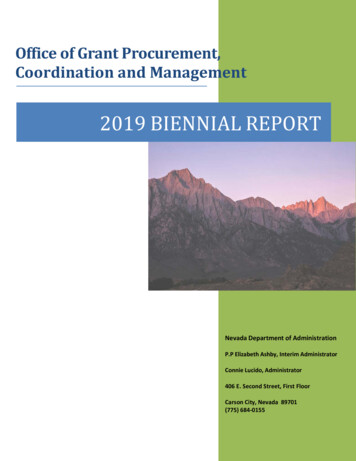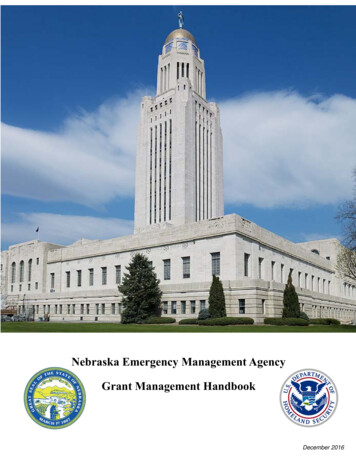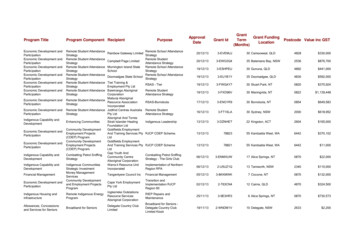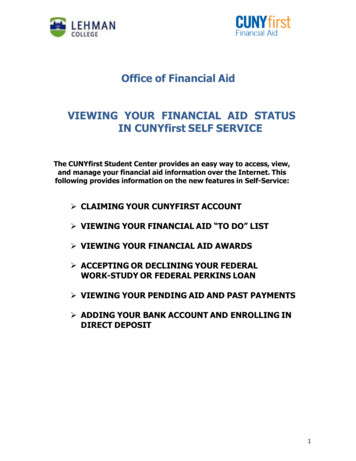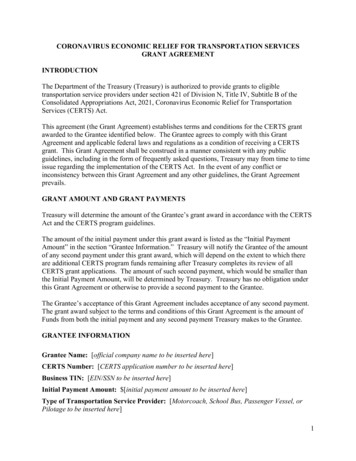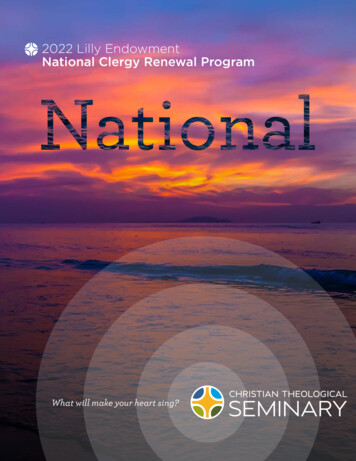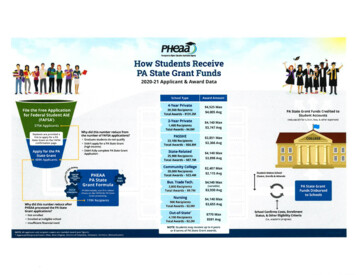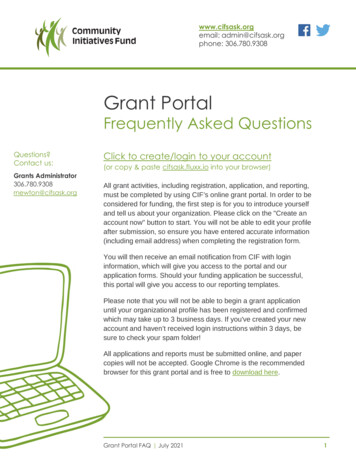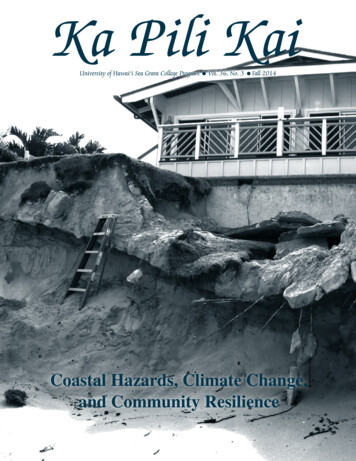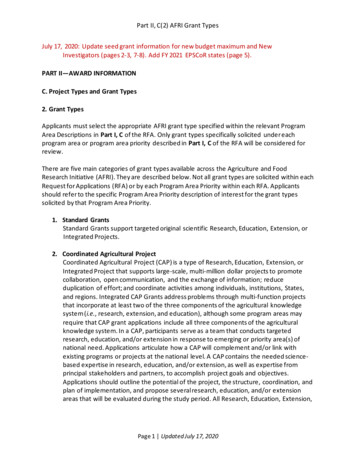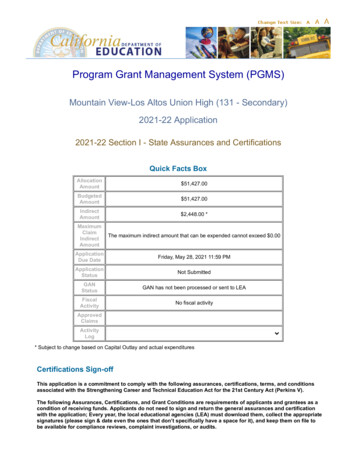
Transcription
Program Grant Management System (PGMS)Mountain View-Los Altos Union High (131 - Secondary)2021-22 Application2021-22 Section I - State Assurances and CertificationsQuick Facts BoxAllocationAmount 51,427.00BudgetedAmount 51,427.00IndirectAmount 2,448.00 *MaximumClaimIndirectAmountThe maximum indirect amount that can be expended cannot exceed 0.00ApplicationDue DateFriday, May 28, 2021 11:59 PMApplicationStatusNot SubmittedGANStatusGAN has not been processed or sent to LEAFiscalActivityNo fiscal activityApprovedClaimsActivityLog* Subject to change based on Capital Outlay and actual expendituresCertifications Sign-offThis application is a commitment to comply with the following assurances, certifications, terms, and conditionsassociated with the Strengthening Career and Technical Education Act for the 21st Century Act (Perkins V).The following Assurances, Certifications, and Grant Conditions are requirements of applicants and grantees as acondition of receiving funds. Applicants do not need to sign and return the general assurances and certificationwith the application; Every year, the local educational agencies (LEA) must download them, collect the appropriatesignatures (please sign & date even the ones that don’t specifically have a space for it), and keep them on file tobe available for compliance reviews, complaint investigations, or audits.
California Department of Education General AssurancesDrug Free Workplace CertificationU.S. Department of Education Debarment and SuspensionU.S. Department of Education LobbyingPerkins V Assurances and Certifications2021–22 Grant ConditionsLEA Sign-offThis application is a commitment to comply with the following assurances, certifications, terms, and conditionsassociated with the Strengthening Career and Technical Education for the 21st Century Act (Perkins V).CDE Review and Sign-offCDE CommentsSection ApprovedSaveCalifornia Department of Education1430 N StreetSacramento, CA 95814Save and Continue to Section IIWeb Pol ic y
Program Grant Management System (PGMS)Mountain View-Los Altos Union High (131 - Secondary)2021-22 Application2021-22 Section II - StakeholdersQuick Facts BoxAllocationAmount 51,427.00BudgetedAmount 51,427.00IndirectAmount 2,448.00 *MaximumClaimIndirectAmountThe maximum indirect amount that can be expended cannot exceed 0.00ApplicationDue DateFriday, May 28, 2021 11:59 PMApplicationStatusNot SubmittedGANStatusGAN has not been processed or sent to LEAFiscalActivityNo fiscal activityApprovedClaimsActivityLog* Subject to change based on Capital Outlay and actual expendituresSpecial Population StakeholdersThe Strengthening Career and Technical Education For the 21st Century Act (Perkins V) requires local educationalagencies (LEAs) to implement strategies To overcome barriers that may be lowering special population students'rates of access to or success in career technical education (CTE) programs assisted with the funds. CTEprograms must be designed to enable special population students to meet the performance level targetsestablished for the programs. These programs must also provide the skills necessary to pursue careers in highskill, high-wage, or in-demand industry sectors or occupations.This form confirms that the LEA coordinators or administrators responsible for each of the programs associatedwith special population groups listed below have contributed to the LEA’s Comprehensive Local NeedsAssessment for the 2020–21 Perkins V application.
Each special population category must be signed by the LEA’s designated administrator or the certificatedrepresentative responsible for that program.Download the Sign-off Form for Representatives of Special Populations, collect the appropriate signatures, andkeep the form on file to be available for compliance reviews, complaint investigations, or audits.Students with Disabilities (Special Education Coordinator/Administrator)NameKathy SulaverTitleDirector of Special EducationEconomically Disadvantaged (Title I Coordinator/Administrator)NameTeri FaughtTitleAssociate Superintendent, Educational ServicesStudents Preparing for Non-Traditional Fields (Title IX Coordinator/Administrator)NameTeri FaughtTitleAssociate Superintendent, Educational ServicesSingle Parent or Single Pregnant Women (Title IX Coordinator/Administrator)NameTeri FaughtTitleAssociate Superintendent, Educational ServicesOut-Of-Workforce Individuals (Title IX Coordinator/Administrator)NameTeri FaughtTitleAssociate Superintendent, Educational ServicesEnglish Language Learners (English Learner Coordinator/Administrator)NameTeri FaughtTitleAssociate Superintendent, Educational ServicesHomelessNameAlba GarzaTitleCommunity Services CoordinatorYouth who are In, or who have aged out Of, the foster care systemNameAlba GarzaTitleCommunity Services CoordinatorYouth with a parent who is on active duty In the militaryNameTeri FaughtTitleAssociate Superintendent, Educational ServicesEditCTE Teacher MatrixFor every CTE teacher in the LEA, enter the following information:1. CTE-eligible credential1A) For each CTE teacher assisted w/ Perkins funds, enter the name of the teacher as it appears on theCTE-eligible credential.
1B) Enter the document number of the CTE-eligible credential. We look up 100% of the entries on the CTCwebsite.1C) Enter the document title of the CTE-eligible credential (i.e., credential type: CTE, Designated Subjects,Vocational, Single Subject, etc).1D) Enter the subject description of the CTE-eligible credential (i.e., subject authorization). For credentialsissued 2008 or later, the subject description should match one of the 15 industry sectors. For credentialsissued before 2008 ('Designated Subjects Vocational'), the subject descriptions do not conform to the 15industry sectors and come from a nearly infinite variety of job titles—type the one from the credential into thisfield.2. The subject of the credential matches the pathway assigned.2A) For each CTE teacher assisted w/ Perkins funds, enter the local name of the site.2B) Enter the name of the site of the pathway.2C) Enter the local name of the pathway if it’s different from the name of the pathway as coded in CALPADS.2D) Enter the official CALPADS pathway name; i.e., the name of the CTE Model Curriculum Standards theteacher covers. If the same teacher is assigned to two or more pathways, list him/her two or more times.1) Teacher Credential and CTE-Eligibility1A) Teacher's Name1B) CTE-Eligible Credential DocumentNumber1C) Document TitleSelect Document Title1D) Subject DescriptionSelect a subject description2) Does the Credential Match the Assignment?2A) Site NameSelect Site2B) Local Name of Pathway2C) CALPADS Pathway NameSelect PathwaySubmit Teacher
1A) CTETeacher'sLast NameByunghoon,Cho1C) DocumentTitle/ 1D) SubjectDescription2A) SiteName2C) CALPADSPathwayStatusCareer TechnicalEducationTeachingCredential -- Arts,Media, &EntertainmentMVLAFreestyleAcademyArts, Media, andEntertainment -Production andManagerial ArtsSubmittedBy LEAFlorendo, Leo Career TechnicalMalquedEducationTeachingCredential -- Arts,Media, &EntertainmentMVLAFreestyleAcademyArts, Media, andEntertainment -Design, Visual,and Media ArtsSubmittedBy LEAParkinson,LeslieJacquelineCareer TechnicalEducationTeachingCredential -- Arts,Media, &EntertainmentMVLAFreestyleAcademyArts, Media, andEntertainment -Design, Visual,and Media ArtsSubmittedBy LEATaylor,MatthewClawsonCareer TechnicalEducationTeachingCredential -- Arts,Media, &EntertainmentMVLAFreestyleAcademyArts, Media, andEntertainment -Design, Visual,and Media ArtsSubmittedBy iewDeleteReviewLEA Sign-offAs the duly authorized representative of the local educational agency applying for the Strengthening Career andTechnical Education for the 21st Century Act, 2021-22 funding, I confirm that the LEA coordinators or administratorsresponsible for each of the programs associated with special population groups have contributed to the LEA’sComprehensive Local Needs Assessment for this application.CDE Review and Sign-offCDE CommentsSection ApprovedSaveCalifornia Department of Education1430 N StreetSacramento, CA 95814Save and Continue to Section IIIWeb P ol ic y
Program Grant Management System (PGMS)Mountain View-Los Altos Union High (131 - Secondary)2021-22 Application2021-22 Section III - State Determined Performance LevelsQuick Facts BoxAllocationAmount 51,427.00BudgetedAmount 51,427.00IndirectAmount 2,448.00 *MaximumClaimIndirectAmountThe maximum indirect amount that can be expended cannot exceed 0.00ApplicationDue DateFriday, May 28, 2021 11:59 PMApplicationStatusNot SubmittedGANStatusGAN has not been processed or sent to LEAFiscalActivityNo fiscal activityApprovedClaimsActivityLog* Subject to change based on Capital Outlay and actual expendituresIndicatorsBaselineLevel1S1: Four-Year Graduation Rate88.10%1S2: Extended Graduation RateN/APerformance LevelsFY2020FY2021FY2022FY202389.10% 89.10% 91.10% 91.10%N/AN/AN/AN/A63.4063.40%2S2: Academic Proficiency in Rereading Language Arts60.60%62.00% 62.00%2S2: Academic Proficiency in Mathematics33.00%34.50% 34.50% 36.50% 36.50%2S3: Academic Proficiency in Science27.70%28.20%3S1: Post-Program Placement67.20%68.00% 68.00% 69.40% 69.40%28.2031.20% 31.20%
4S1: Non-traditional Program Concentration20.80%5S1: Program Quality – Attained Recognized PostsecondaryCredential20.80% 20.80% 21.00% 21.00%N/AN/AN/A21.60%23.90%23.905S3: Program Quality – Participated in Work-Based LearningN/AN/AN/AN/AN/A5S4: Program Quality - OtherN/AN/AN/AN/AN/A5S2: Program Quality – Attained Postsecondary CreditsN/AN/A26.20% 26.20%The table above lists the State Determined Performance Levels (SDPLs) (formerly State Targets) for every sub-group. Notethat future targets are likely to change as actual state-wide performance levels are gathered.The Perkins V law defines special populations as individuals with disabilities; individuals from economically disadvantagedfamilies, including low-income youth and adults; individuals preparing for nontraditional fields; single parents, includingsingle pregnant women; out-of-workforce individuals; English language learners; homeless individuals; youth who are in, orwho have aged out of, the foster care system; and youth with a parent who is on active duty in the military.For reporting purposes in Perkins V, a 'completer' is defined as a student who has completed a high-quality CTE pathway ofnot less than 300 hours, with a C- or better in the capstone class, and exited secondary education.Under Perkins V, California defines a 'concentrator' as a student who has completed a high-quality CTE pathway of not lessthan 300 hours, with a C- or better in the capstone class, and exited secondary education.California’s College/Career Readiness Indicator (CCI) tracks graduation cohorts who also meet one or more definedcategories. For categories involving CTE completion, the student must have completed a high-quality CTE pathway of notless than 300 hours with a C- or better in the capstone class.LEA Sign-offLEA Section Sign-offCDE Review and Sign-offCDE CommentsSection ApprovedSaveCalifornia Department of Education1430 N StreetSacramento, CA 95814Save and Continue to Section IVWeb Pol ic y
Program Grant Management System (PGMS)Mountain View-Los Altos Union High (131 - Secondary)2021-22 Application2021-22 Section IV - Comprehensive Local Needs Assessment (CLNA)Reporting Template & Local Application RequirementsQuick Facts BoxAllocationAmount 51,427.00BudgetedAmount 51,427.00IndirectAmount 2,448.00 *MaximumClaimIndirectAmountThe maximum indirect amount that can be expended cannot exceed 0.00ApplicationDue DateFriday, May 28, 2021 11:59 PMApplicationStatusNot SubmittedGANStatusGAN has not been processed or sent to LEAFiscalActivityNo fiscal activityApprovedClaimsActivityLog* Subject to change based on Capital Outlay and actual expendituresIntroductionThe Strengthening Career and Technical Education for the 21st Century Act (Perkins V) requires all eligible recipients ofPerkins V funds to complete a Comprehensive Local Needs Assessment (CLNA) and use that information to develop theeligible recipient’s local application plan. One of the most significant changes within the Perkins V federal legislation is theintroduction of the CLNA. Conducting the CLNA is described under Perkins V subsection 134(c), and developing the localapplication is described in Perkins V subsection 134(b). The CLNA must be completed by eligible grant recipients of PerkinsV funds at the beginning of the grant period and updated at least once every two years.
Perkins V requires eligible grant recipients to use a data-driven decision-making process on local planning and spending oncareer technical education (CTE). The CLNA is a review of a number of elements, including student performance data,especially gaps among sub-groups of special population; labor market needs; educator development; equity and access forspecial populations, and program size, scope and quality. To validate the information obtained through the CLNA, an eligiblePerkins V grant recipient shall involve a diverse body of stakeholders, including, at a minimum—secondary andpostsecondary educators, business and industry partners, parents and students among others. More importantly, localplanning, program, and funding decisions must be based on the CLNA with the primary purpose of improving overallperformance and reducing performance gaps between different special population subgroups.The goal of the CLNA is to help educators identify, understand, and prioritize the needs that districts and schools mustaddress to improve performance and decrease performance gaps. Identifying priority needs is the first in a series of closelytied steps that also include understanding root causes that contribute to the areas of need, selecting evidence basedstrategies that address those areas, preparing for and implementing selected strategies, and evaluating whether thosestrategies are addressing improvement needs and achieving desired results.DirectionsEach question below is meant to be a concise and complete1 summary of the CLNA developed by each local educationalagency (LEA). The Workbook To Accompany the CLNA Reporting Template offers a more In-depth exploration Of Eachquestion from the CLNA Reporting Template to guide and inspire LEAs as they engage their required stakeholders in theconstruction of their CLNA. Each section is based on a separate requirement from the Perkins V law, Section 134, (b) (1–9)and subsection c, of what must be contained in a CLNA and a local Perkins application.The responses from the seven questions in the 'CLNA Reporting Template' and the subsequent eight questions in the'Meeting the Perkins V Local Application Requirements' are required to be:1. Included in the annual Perkins renewal application via the California Department of Education’s (CDE) onlineProgram Grant Management System, Section IV2. Printed and signed by the LEA Perkins Coordinator and Stakeholder/CTE Advisory Committee Chairperson, to bekept on file and available for compliance reviews, reviews, complaint investigations, or audits, along with all otherevidence of a complete CLNA process.CLNA Reporting Template1. Section 134(c)(d)(e): Stakeholder Consultation on the CLNA, Dates, Content, and Membership:i. What was the date of the eligible grant recipient’s most recent district-wide CTE Advisory orStakeholder Engagement meeting that served as the source for constructing the LEA’s CLNA?Freestyle has its own advisory meeting schedule, specific to the three pathways offered at Freestyle. Both ofour comprehensive high schools also have advisory committees that meet typically three times a year. Weare now in the process of moving toward at least one joint, district-wide meeting every year to discussmatters that cut across all our programs. The meeting on 4/30/2021 was designed to calibrate ourperceptions about the three programs in our district and help everyone understand the basics that qualify aprogram to be considered a high-quality CTE Program. Members present at 4/30/2021 Meeting BrigitteSarraf Adam Anderson Dilloughery, Brendan Leo Florendo Ly Nguyen Lydia Conoway Marcey WinawerStephen Hine Adam Anderson Jeanne Yu Brent Smith Sarah Alvarado Scott Murray Theresa Dunlap(Maximum 5000 Characters)ii. The basis for that meeting should have included a discussion/agreement of the eligible grantrecipient’s Perkins V accountability indicators plus a self-evaluation, as detailed in the “Workbook toAccompany the CLNA Reporting Template.” Was the eligible grant recipient’s previous selfevaluation based on the Carl D. Perkins Career and Technical Education Act of 2006 (Perkins IV) “11Elements of a High-Quality CTE Program” aka the “CTE Self-Review,” the CTEIG Self Review Rubric,or Workbook to Accompany the CLNA Reporting Template? How will the eligible grant recipientmove towards the 12 Essential Elements of a High-Quality College and Career Pathway, which aresupported by the Guiding Policy Principles to Support Student-Centered K–14 Pathways,established by the California Workforce Pathways Joint Advisory Committee (CWPJAC)? TheGuiding Policy Principles to Support Student-Centered K–14 Pathways can be found on theCWPJAC’s web page at, https://www.cde.ca.gov/ci/ct/gi/guidingpps.asp.
Since 2006, self-evaluation by staff at Freestyle has been based on elements of -Student-Centered Deliveryof Services -Equity -Access -Leadership at All Levels -High-Quality, Integrated Curriculum and Instruction Skilled Instruction and Educational Leadership, informed by Professional Learning -Career Exploration andStudent Supports -Appropriate Use of Data and Continuous Improvement -Cross-System Alignment -StrongPartnerships with Industry We will strive to also include -Intentional Recruitment and Marketing (Promotion,Outreach, and Communication) -Sustained Investments and Funding through Mutual Agreements In additionto using the 11 Elements, we use the feedback from our Industry Partners to assess and validate the qualityand effectiveness of our programs.(Maximum 5000 Characters)iii. What is the date of the eligible grant recipient's next district-wide CTE Advisory or StakeholderEngagement meeting that will review, evaluate, & identify needs per Section 134(c), ComprehensiveNeeds Assessment, and Section 134(e), Continued Consultation?Pre-COVID, our end-of-the-year Showcase Unit for Seniors brings Industry Professionals and our studentstogether where industry professionals review and offer feedback on student work and ways to improve forthe next phase of their career. We will bring back industry professionals again in Spring 2022 for ourShowcase Unit assuming health conditions allow it.(Maximum 5000 Characters)iv. For the meeting reported in question 1A, were all required categories of stakeholders present? If not,list which categories of stakeholders were missing and describe the effort in getting them there.What will be done to ensure they will be present for the next stakeholder engagement meeting toupdate the CLNA and to evaluate the effectiveness of previous strategies chosen?The district is part of an SWF consortium that provides us access to Earn and Learn, an East Bayorganization that helps connect schools and students with WBL opportunities. Our next district-wide meetingwas going to be training for Advisory Committee members on the Earn/Learn Platform and an opportunity togain input from our Industry Partners on how to best go forward in connecting with companies to forgerelationships that will make work-based learning a reality.(Maximum 5000 Characters)2. Section 134(c)(2)(A): Student Performance on Required Performance Indicators (Disaggregated)Freestyle has been the shining star in the district is successfully preparing students for careers in the three pathwaysthat Freestyle offers. Many of our graduates enter post-secondary schools with majors in the area of their chosenpathways. While attending Freestyle, every student is also dual-enrolled in a Community College class. Many of ourstudents are offered paid contracts for work projects they do for private businesses and companies while enrolled atFreestyle. Our data includes: 76% of 2020-2021 students received post-secondary credit. 97% of the FreestyleClass of 2020 attended college. 2 students did not report post high school plans. 66% of 2019-2020 studentsreceived post-secondary credit. 100% of the Freestyle Class of 2019 attended college. 61% of 2018-2019 studentsreceived post-secondary credit. 98% of the Freestyle Class of 2018 attended college. 1 student did not report posthigh school plans. 62% of 2017-2018 students received post-secondary credit.(Maximum 10000 Characters)3. Section 134(c)(2)(B)(i): Program Size, Scope, and Quality to Meet the Needs of All StudentsAll students at Freestyle choose either Design, Film, or Animation as their strand of concentration. In addition toclasses in their chosen field, each student then enrolls in Digital Media and English for a total of 3 classes each ofthe 2 years they attend Freestyle Academy as a Junior and a Senior. Classroom facilities limit the student numbersto 80 Juniors and 80 Seniors for a total of 160 maximum students. In addition, students at Freestyle are alsostudents at two different comprehensive schools within the MVLA District.(Maximum 5000 Characters)4. Section 134(c)(2)(C): Progress Towards Implementation of CTE Programs of StudyFreestyle has three highly developed pathways. The program has cutting-edge equipment and the pathways weredeveloped on the basis of Labor-market data, designating these fields as high-wage, high-need. All students atFreestyle choose either Design, Film, or Animation as their strand of concentration. In addition to classes in theirchosen field, each student then enrolls in Digital Media and English. Classroom facilities at Freestyle Academy limitthe program size to 3 CTE Programs of Study - Design, Film Production, and Animation with a maximum of 160students.(Maximum 5000 Characters)5. Section 134(c)(2)(D): Improving recruitment, retention, and training of CTE teachers and paraprofessionals,including underrepresented groupsAll of the district’s teachers either have the appropriate CTE credential or are in the process of obtaining one, as isthe case with one employee. Most of our teachers have been with us for years. Professional Development is
provided at different levels, mostly sponsored through our Curriculum Institute. This includes compensating our staffto attend conferences and workshops; take course work required for the completion of their credentials; meet on aregular basis to share best practices; attend events sponsored by local industries, and work collaboratively with ourCommunity College Partners on the expansion of our pathways. Because of the unique curriculum at FreestyleAcademy, Professional Development for staff is at an individual level utilizing resources such as Linked In Learningvideo tutorials and other online resources specific for each staff members’ needs. Software and hardware updatesoften require staff to keep up to date on the latest additions and modifications. The Freestyle Program has notrecently expanded with more classes justifying no need for more recruitment of teachers. Retention of current staff isof utmost importance for continuity for students and the program. Staff are in unending discussions about curriculumchanges based on student performance and current trends in the industry.(Maximum 5000 Characters)6. Section 134(c)(2)(E): Progress Towards Equal Access to CTE Programs for All Students. In your summary ofthe discussion with Stakeholders, you must describe each of the following three points. Strategies toovercome barriers that result in:i. lower rates of access to, or performance gaps in, the courses and programs for special populations;Freestyle serves all students. The program was created with a vision to offer high-quality programs that havethe power to re-engage the “disenfranchised” student, often students who are bored or who have not beenable to find anything to be passionate about. Freestyle offers an abundance of opportunities for students withlatent passion in the areas of design, communication, photography, illustrations, web design, musiccomposition, film, and animation. Our CTE programs at the comprehensive high schools all include classesthat are specifically designed to attract and be accessible to ELL and SPED students. All juniors and seniorswho meet the requirements have the ability to apply and attend Freestyle. Freestyle admits students on alottery system when the number of applicants exceeds maximum capacity. Freestyle actively recruitsstudents from all backgrounds and places extra attention on recruiting females, English learners, Studentswith Disabilities, and Socio-Economically Disadvantaged students. All students in Freestyle use the sameprofessional standard equipment purchased with the Perkins grant to make their artistic vision becomereality. The ease of use with this equipment will support a higher success with all students including specialpopulations, with all their projects eliminating possible rendering pitfalls, tech issues, and delays with 4Kvideo editing and rendering. Such problems often lead to the feeling of not being successful with videoprojects. Equipment and software can be adjusted for ease of use for any student who requires it.(Maximum 5000 Characters)ii. Providing programs that are designed to enable special populations to meet the local levels ofperformance;Freestyle provides access to all students, including special populations, to find their passion in the digitalmedia arts. Although Freestyle classes are not specifically designed for special populations, the curriculumcan be easily modified for individuals in a special population.(Maximum 5000 Characters)iii. Providing activities to prepare special populations for high-skill, high-wage, or in-demand industrysectors or occupations in competitive, integrated settings that will lead to self-sufficiency.Any student, including special populations, who completes the Freestyle Program is prepared for high-skill,high-wage, or in-demand industry sectors or occupations in competitive, integrated settings. All of ourproject-based curricula require various 21st Century Skills that we emphasize: Visual Literacy, TechnologicalLiteracy, Creativity, Self Direction, High Productivity, Teaming and Collaboration, Social and CivicResponsibility, and Risk Taking.(Maximum 5000 Characters)7. Section 134(c)(2)(B)(ii): Alignment to Labor Market InformationAccording to the California Labor Market Information, the industries taught at Freestyle Academy are in alignmentwith the top paying and fasting growing non-medical occupations and job openings projected for 2016-2026(Maximum 5000 Characters)Local Application RequirementsOnce the LEA completes their CLNA Reporting Template above, the LEA must use that information to address the nineseparate required elements identified within the Perkins V legislation. The elements are provided below and must becompleted by the LEA and then entered along with the CLNA Reporting Template into the CDE online Program GrantManagement System, Section 4.
Section 134(b)(2)(A-C) refers to information on the CTE course offerings and activities that the eligiblerecipient will provide with funds under this part, which shall include not less than one program of studyapproved by a State under Section 124(b)(2). Indicate how the results of the CLNA:1.i. Informs the selection of the specific CTE programs and activities selected to be funded;ii. describes any new programs of study the eligible recipient will develop and submit to the State forapproval;iii. Shows how students, including students who are members of special populations, will learn abouttheir school’s CTE course offerings and whether each course is part of a CTE program of study.Freestyle actively recruits students of all populations to their CTE course offerings through email lists, videoadvertisements to all district students, online gallery exhibitions of student work, and peer-to-peer student recruiting.The Freestyle website https://freestyleacademky.rocks features an FAQ page, student testimonials, alumniinformation, equipment information, curriculum information, class information, galleries of student productions, andof course application information. At other comprehensive schools in the district, a large TV featuring a 17-hour loopof student projects is prominently placed in the school library so that interested students can see past studentproductions.(Maximum 5000 Characters)2. Section 134(b)(3)(A-C) refers to how the eligible recipient, in collaboration with local workforce developmentboards and other local workforce agencies, one-stop delivery systems, and other partners, will use theinformation provided through the CLNA to describe the following:i. Career exploration and career development coursework, activities, or services;ii. career information on employment opportunities that incorporate the most up-to-date information onhigh-skill, high-wage, or in-demand industry sectors or occupations;iii. An organized system of career guidance and academic counseling to students before enrolling andwhile participating in a career and technical education program.The Freestyle website (https://freestyleacademy.rocks/about) relates the Freestyle curriculum with careerinformation with the updated 2021 Otis College Report on the Creative Economy inment-digital-services)(Maximum 5000 Characters)3. Section 134(b)(4): describe how the eligible recipient will improve the academic and technical skills ofstudents participating in CTE programs by strengthening the academic and CTE components of suchprograms through the integration of coherent and rigorous content aligned with challe
1C) Enter the document title of the CTE-eligible credential (i.e., credential type: CTE, Designated Subjects, Vocational, Single Subject, etc). 1D) Enter the subject description of the CTE-eligible credential (i.e., subject authorization). For credentials issued 2008 or later, the subject description should match one of the 15 industry sectors.
